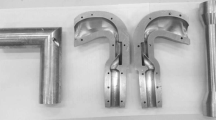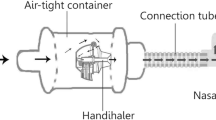Abstract
Purpose
We hypothesize that the USP induction port may de-agglomerate carrier-free powder emitting from dry powder inhalers (DPIs).
Methods
Aerosols emitting from a range of DPIs (Spinhaler®, Turbuhaler® and OsmohalerTM) and induction ports (USP throat, straight tube, Alberta idealized mouth-throat geometry (AG)) were sized by laser diffraction. Total drug recovery was obtained by HPLC and fine particle fraction computed. Air flow patterns were simulated using Computational Fluid Dynamics (CFD).
Results
The straight tube did not de-agglomerate emitted powder. However, the USP throat and AG further de-agglomerated powders from the Spinhaler, but not the Turbuhaler and Osmohaler. While budesonide powder deposited similarly in all induction ports, deposition was significantly higher in the AG for both DSCG and mannitol. CFD revealed agglomerates impacting on the USP throat with higher localized velocity compared with the straight tube. CFD further showed a more complex flow pattern with high-velocity air jets in the AG, which explains the higher FPF for DSCG and the lower FPF for mannitol using the AG.
Conclusion
The USP throat further de-agglomerated the emitted powder from the DPI when it did not sufficiently disperse the powder. Other tools such as laser diffraction may be used for cross-examining to avoid artifacts in the results.

















Similar content being viewed by others
References
Chapter <601>. United States Pharmacopeia 31 - National Formulary 26. United States Pharmacopeial Convention Inc, 2008.
Adi S, Tong Z, Chan H-K, Yang R, Yu A. Impact angles as an alternative way to improve aersolisation of powders for inhalation? Eur J Pharm Sci. 2010;41(2):320–7.
Endo Y, Hasebe S, Kousaka Y. Dispersion of aggregates of fine powder by acceleration in an air stream and its application to the evaluation of adhesion between particles. Powder Technol. 1997;91:25–30.
Tong ZB, Yang RY, Chu KW, Yu AB, Adi S, Chan HK. Numerical study of the effects of particle size and polydispersity on the agglomerate dispersion in a cyclonic flow. Chem Eng J. 2010;164:432–41.
Zeng XM, Martin GP, Marriott C. Particulate interactions in dry powder formulatinos for inhalation. London: Taylor and Francis; 2001.
Matida EA, Finlay WH, Breuer M, Lange CF. Improving prediction of aerosol deposition in an idealizedmouth using large eddy simluation. J Aerosol Med. 2006;19(3):290–300.
Matida EA, Finaly WH, Lange CF, Grgic B. Improved numerical simulation of aerosol deposition in an idealized mouth-throat. J Aerosol Sci. 2004;35:1–19.
Stapleton KW, Guentsch E, Hoskinson MK, Finlay WH. On the suitability of k-ε turbulence modelling for aerosol deposition in the mouth and throat: a comparison with experiment. J Aerosol Sci. 2000;31(6):739–49.
Ilie M, Matida EA, Finlay WH. Asymmetrical aerosol deposition in an idealized mouth with a DPI mouthpiece inlet. Aerosol Sci Tech. 2007;42(1):10–7.
Grgic B, Finlay WH, Heenan AF. Regional aerosol deposition and flow measurements in an idealized mouth and throat. J Aerosol Sci. 2004;35:21–32.
Zhang Y, Gilbertson K, Finlay WH. In vivo-in vitro comparison of deposition in three mouth-throat models with Qvar® and Turbuhaler® inhalers. J Aerosol Med. 2007;20(3):227–35.
Clark AR, Hollingsworth AM. The relationship between powder inhaler resistance and peak inspiratory conditions in healthy volunteers—implications for in vitro testing. J Aerosol Med. 1993;6(2):99–113.
Janssens W, VandenBrande P, Hardeman E, De Langhe E, Philps T, Troosters T, et al. Inspiratory flow rates at different levels of resistance in elderly COPD patients. Eur Respir J. 2008;31:78–83.
Burnell PKP, Small T, Doig S, Johal B, Jenkins R, Gibson GJ. Ex-vivo product performance of DiskusTM and TurbuhalerTM inhalers using inhalation profiles from patients with sever chronic obstructive pulmonary disease. Resp Med. 2001;95:324–30.
Wang ZL, Grgic B, Finaly WH. A dry powder inhaler with reduced mouth-throat deposition. J Aerosol Med. 2006;19:168–74.
Chu KW, Wang B, Yu AB, Vince A. CFD-DEM modelling of multiphase flow in dense medium cyclones. Powder Technol. 2009;193:235–47.
Yang RY, Zou RP, Yu AB. Computer simulation of the packing of fine particles. Phys Rev E. 2000;62:3900–8.
Steckel H, Mȕller BW. In vitro evaluation of dry powder inhalers I: drug deposition of commonly used devices. Int J Pharm. 1997;154:19–29.
Steckel H, Rasenack N, Mȕller BW. In-situ micronization of disodium cromoglycate for pulmonary delivery. Eur J Pharm Biopharm. 2003;55:173–80.
Tong ZB, Adi S, Yang RY, Chan HK, Yu AB. Numerical investigation of the de-agglomeration mechanisms of fine powders on mechanical impaction. J Aerosol Sci. 2011;42:811–9.
Tong ZB, Yang RY, Chu KW, Yu AB, Adi S, Chan HK. Numerical study of the effects of particle size and polydispersity on the agglomerate dispersion in a cyclonic flow. Chem Eng J. 2010;164:432–41.
Zhang Y, Gilbertson K, Finlay WH. In vivo-in vitro comparison of deposition in three mouth-throat models with Qvar® and Turbuhaler® inhalers. J Aerosol Med. 2007;20:227–35.
Acknowledgments & DISCLOSURES
This work was funded by a grant from the Australian Research Council. The authors would like to acknowledge that the source of the Alberta geometry used in this work was kindly provided from Dr. Finlay’s Aerosol Research Laboratory of Alberta at the University of Alberta, Canada.
Author information
Authors and Affiliations
Corresponding author
Rights and permissions
About this article
Cite this article
Tang, P., Kwok, P.C.L., Tong, Z. et al. Does the United States Pharmacopeia Throat Introduce De-agglomeration of Carrier-Free Powder from Inhalers?. Pharm Res 29, 1797–1807 (2012). https://doi.org/10.1007/s11095-012-0703-y
Received:
Accepted:
Published:
Issue Date:
DOI: https://doi.org/10.1007/s11095-012-0703-y




